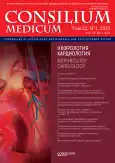Left ventricular myocardial dysfunction and parameters of ambulatory blood pressure monitoring in patients with arterial hypertension and frailty
- Authors: Fomina E.S.1, Nikiforov V.S.1, Frolova E.V.1, Reshetnik D.A.2
-
Affiliations:
- Mechnikov North-Western State Medical University
- Nikolayevskaya Hospital
- Issue: Vol 23, No 1 (2021)
- Pages: 80-83
- Section: Articles
- URL: https://journals.rcsi.science/2075-1753/article/view/95442
- DOI: https://doi.org/10.26442/20751753.2021.1.200476
- ID: 95442
Cite item
Full Text
Abstract
Full Text
##article.viewOnOriginalSite##About the authors
Elena S. Fomina
Mechnikov North-Western State Medical University
Email: el.fomina@bk.ru
зав. отд-нием функциональной диагностики Saint Petersburg, Russia
Viktor S. Nikiforov
Mechnikov North-Western State Medical Universityд-р мед. наук, проф. Saint Petersburg, Russia
Elena V. Frolova
Mechnikov North-Western State Medical Universityд-р мед. наук, проф. каф. Saint Petersburg, Russia
Dmitrii A. Reshetnik
Nikolayevskaya Hospitalд-р мед. наук, глав. врач Saint Petersburg, Russia
References
- Bilen O, Wenger NK. Hypertension management in older adults. F1000Res. 2020; 9: F1000 Faculty Rev-1003. doi: 10.12688/f1000research.20323.1
- Liu P, Li Y, Zhang Y, et al. Frailty and hypertension in older adults: current understanding and future perspectives. Hypertens Res 2020. doi: 10.1038/s41440-020-0510-5
- Oliveros E, Patel H, Kyung S, et al. Hypertension in older adults: Assessment, management, and challenges. Clin Cardiol 2020; 43 (2): 99-107. doi: 10.1002/clc.23303
- Mitnitski A, Song X, Rockwood K. Assessing biological aging: the origin of deficit accumulation. Biogerontology 2013; 14 (6): 709-17. doi: 10.1007/s10522-013-9446-3
- Ungvari Z, Tarantini S, Donato AJ, et al. Mechanisms of Vascular Aging. Circ Res 2018; 123 (7): 849-67. doi: 10.1161/CIRCRESAHA.118.311378
- Ткачева О.Н., Котовская Ю.В., Рунихина Н.К., и др. Клинические рекомендации «Старческая астения». Рос. журн. гериатрической медицины. 2020; 1: 11-46 [Tkacheva O.N., Kotovs-kaya Yu.V., Runikhina N.K., et al. Klinicheskie rekomendatsii “Starcheskaya asteniya”. Russian Journal of Geriatric Medicine. 2020; 1: 11-46 (in Russian).]
- Afilalo J. Frailty in Patients with Cardiovascular Disease: Why, When, and How to Measure. Curr Cardiovasc Risk Rep 2011; 5 (5): 467-72. doi: 10.1007/s12170-011-0186-0
- Орлова Я.А., Ткачева О.Н., Арутюнов Г.П., и др. Особенности диагностики и лечения хронической сердечной недостаточности у пациентов пожилого возраста. Мнение экспертов Общества специалистов по сердечной недостаточности, Российской ассоциации геронтологов и гериатров и Евразийской ассоциации терапевтов. Кардиология. 2018; 12 (58): 4272
- Никифоров В.С., Марсальская О.А., Новиков В.И. Эхокардиографическая оценка деформации миокарда в клинической практике. СПб.: КультИнформПресс, 2015
- Benetos A, Petrovic M, Strandberg T Hypertension Management in Older and Frail Older Patients. Circ Res 2019; 124 (7): 1045-60. doi: 10.1161/CIRCRESAHA.118.313236
- Ткачева О.Н., Рунихина Н.К., Котовская Ю.В., и др. Лечение артериальной гипертонии у пациентов 80 лет и старше и пациентов со старческой астенией. Кардиоваскулярная терапия и профилактика. 2017; 16 (1): 8-21
- Никифоров В.С., Свистов А.С. Современные направления применения ингибиторов ан-гиотензин-превращающего фермента в клинической практике. ФАРМиндекс: Практик. 2005; 7: 21-31
- Липатова Т.Е., Тюльтяева Л.А., Денисова Т.П., Шульпина Н.Ю. Старческая астения и артериальная гипертензия (лекция). Саратовский науч.-мед. журн. 2019; 15 (3): 757-63
- Marwick TH, Gillebert TC, Aurigemma G, et al. Recommendations on the Use of Echocardiography in Adult Hypertension: A Report from the European Association of Cardiovascular Imaging (EACVI) and the American Society of Echocardiography (ASE). J Am Soc Echocardiogr 2015; 28 (7): 72754. doi: 10.1016/j.echo.2015.05.002
- Никифоров В.С., Чекина Н.М., Лунина М.Д., Утехина Г.А. Амбулаторное мониторирование артериального давления. СПб.: КультИнформПресс, 2015
- Анисимов В.Н. Молекулярные и физиологические механизмы старения. В 2 т. Т. 1. СПб.: Наука, 2008
- Baker J, Kimpinski K. Role of melatonin in blood pressure regulation: An adjunct anti-hypertensive agent. Clin Exp Pharmacol Physiol 2018; 45 (8): 755-66. doi: 10.1111/1440-1681.12942
- Luers C, Trippel TD, Seelander S, et al. Arterial stiffness and elevated left ventricular filling pressure in patients at risk for the development or a previous diagnosis of HF-A subgroup analysis from the DIAST-CHF study. J Am Soc Hypertens 2017; 11 (5): 303-13. doi: 10.1016/j.jash.2017.03.006
Supplementary files






